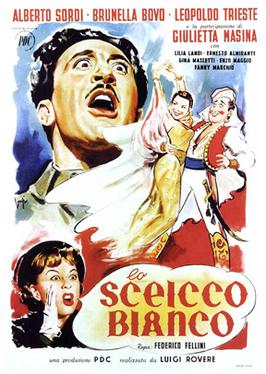 |
| Franco Fabrizi, Franco Interlenghi, Leopoldo Trieste, Riccardo Fellini, and Alberto Sordi in I Vitelloni |
Moraldo Rubini: Franco Interlenghi
Alberto: Alberto Sordi
Fausto Moretti: Franco Fabrizi
Leopoldo Vannucci: Leopoldo Trieste
Riccardo: Riccardo Fellini
Sandra Rubini: Leonora Ruffo
Francesco Moretti: Jean Brochard
Sergio Natali: Achille Majeroni
Guido: Guido Martufi
Director: Federico Fellini
Screenplay: Federico Fellini, Ennio Flaiano, Tullio Pinelli
Cinematography: Carlo Carlini, Otello Martelli, Luciano Trasati
Production design: Mario Chiari
Film editing: Rolando Benedetti
Music: Nino Rota
The international success of
I Vitelloni launched Federico Fellini's directing career after the comparative failures of
Variety Lights (1951), which he co-directed with Alberto Lattuada, and
The White Sheik (1952), his first solo directing effort. It also earned him an Oscar nomination for screenwriting, which he shared with Ennio Flaiano and Tullio Pinelli. It's certainly one of his most endearing early films, made before his familiar mannerisms set in -- though there are glimpses of those in the tawdry theatrical sequence with the grotesque aging actor played by Achille Majeroni (a part that Fellini tried to persuade Vittorio De Sica to play). But somehow it has taken me several viewings over the years to fully appreciate it. I think that's because Fellini's greatest films have a strong central character -- usually played by Giulietta Masini or Marcello Mastroianni -- to hold the narrative together.
I Vitelloni is by definition and title an ensemble picture, but it's also the first of Fellini's excursions into himself, concluding with the Fellini surrogate, Moraldo Rubini boarding a train that will take him away from the idlers of his provincial home town -- and presumably to Rome, where he will become the jaded Marcello Rubini of
La Dolce Vita (1960) and the blocked director Guido Anselmi of
8 1/2 (1963). The problem is that the character of Moraldo isn't written strongly enough or given enough substance by the actor: Franco Interlenghi, who was discovered by Roberto Rossellini and cast in
Shoeshine (1946), had a long career in films and TV in Italy, but the part in
I Vitelloni demands someone with more charisma -- a young Mastroianni, in short. Moraldo is overshadowed by the womanizing Fausto and by the comic figures of Alberto and Leopoldo. The scenes that should develop Moraldo as a central figure don't quite work, particularly the early-morning encounters with Guido, a boy on his way to work at the railroad station -- a sharp counterpoint to the idling
vitelloni. "Are you happy?" Moraldo asks the boy. "Why not?" he replies. The exchange seems designed to undercut the frenetic strivings and complaints of the
vitelloni, who chafe against the boredom and provinciality of the town, but don't seem to be able to muster enough resolve to do something about it, instead continuing to pursue phantoms of creative or sexual success. The trouble with the Moraldo-Guido scenes is that they come out of nowhere narratively -- and even have oddly uncomfortable (and probably unintended) hints of pedophilia on Moraldo's part. Nor do they satisfactorily set up the film's ending: Moraldo departs and we see Guido walking along the train tracks, the former facing up to the uncertain future, the latter heading comfortably back into his routine. Still, it's a film held together by the score by Fellini's great collaborator Nino Rota, and filled with the boundless energy that often rescued Fellini from his worst impulses.
















